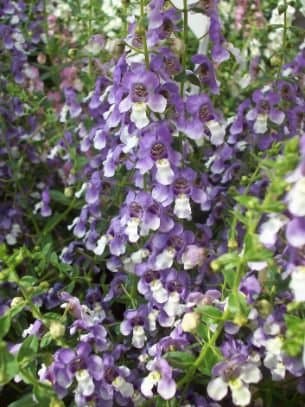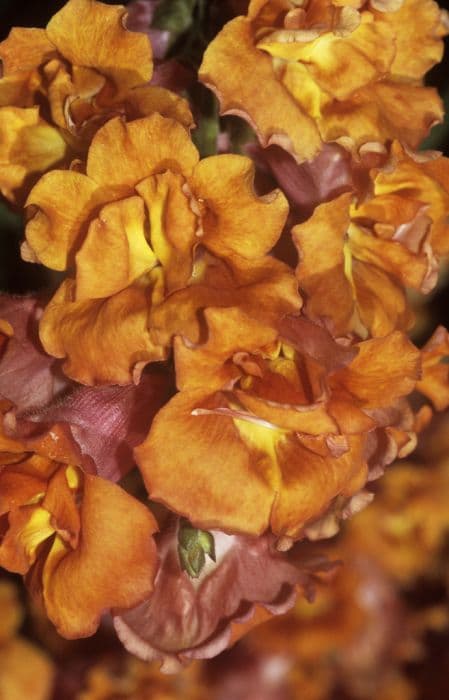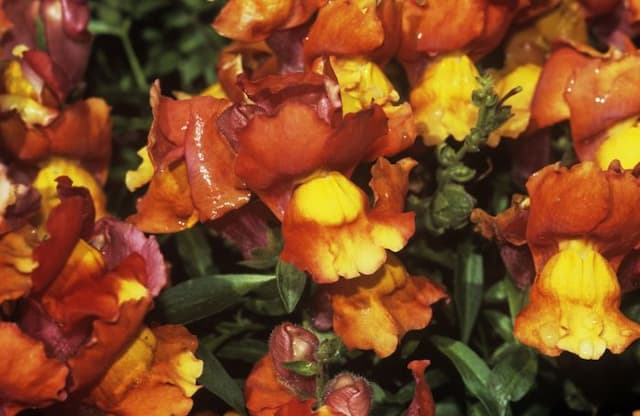Chinese Foxglove Rehmannia elata

ABOUT
The Rehmannia elata, also known as the Chinese Foxglove, is a perennial plant known for its stunning floral display and lush foliage. The leaves of the Chinese Foxglove are large, oval to lanceolate in shape, with a deep green hue and a slightly corrugated texture. The edges of the leaves are usually toothed, providing them with a somewhat jagged appearance. The most striking feature of the Chinese Foxglove is its flowers. They bloom on tall, upright spikes that rise above the foliage. Each flower spike is densely packed with tubular blossoms that are typically a vibrant pink or purplish color. The inside of the flower tubes is often spotted or marked with contrasting yellow throats, which adds to their visual appeal. The Chinese Foxglove's flowers often have a delicate and fine velvety texture with a slightly ruffled or flared mouth. These characteristic blossoms attract various pollinators to the garden, including bees and hummingbirds, adding to the plant's charm and its role in the ecosystem. The plant forms a clump-like structure, which provides a lush base for the striking flower spikes, creating an attractive backdrop for borders or as a feature in a flower garden. The overall impression of the Chinese Foxglove is one of lush foliage paired with beautiful, abundant floral spikes that can give a touch of elegance and exotic flair to any garden setting.
About this plant
 Names
NamesSynonyms
Chinese Foxglove
Common names
Rehmannia angulata, Rehmannia piasezkii, Rehmannia elata var. angulata.
 Toxicity
ToxicityTo humans
Chinese Foxglove (Rehmannia elata) is not commonly known to be toxic to humans. There are no well-documented symptoms of poisoning from the ingestion of Chinese Foxglove, and it has been used in traditional Chinese medicine. However, as with any plant, individual allergies and reactions can occur, so it is generally advisable to avoid ingesting parts of plants that are not commonly recognized as food unless under the guidance of a qualified professional.
To pets
Chinese Foxglove is also not widely recognized as a toxic plant to pets. There is limited information on its effects if ingested by animals such as dogs and cats, but there are no major reports of toxicity from ingestion. As with humans, pet owners should be cautious and prevent their pets from consuming plants not expressly meant for their consumption to avoid any potential adverse reactions. If you suspect your pet has ingested Chinese Foxglove and is showing signs of illness, consult a veterinarian.
 Characteristics
CharacteristicsLife cycle
Perennials
Foliage type
Deciduous
Color of leaves
Green
Flower color
Pink
Height
3 feet (0.91 meters)
Spread
2 feet (0.61 meters)
Plant type
Herb
Hardiness zones
7
Native area
China
Benefits
 General Benefits
General Benefits- Ornamental value - Rehmannia elata, commonly known as Chinese foxglove, has attractive tubular flowers that enhance the beauty of gardens and landscapes.
- Pollinator attractant - The flowers of the Chinese foxglove can attract bees, butterflies, and other beneficial insects, supporting biodiversity.
- Adaptability - The plant is adaptable to a variety of soil types and conditions, making it a versatile choice for gardeners.
- Drought tolerance - Once established, Chinese foxglove can tolerate periods of drought, reducing the need for frequent watering.
- Perennial growth - As a perennial plant, Chinese foxglove can provide long-term presence in the garden, regrowing each spring after dormancy.
- Erosion control - The root system of Rehmannia elata can help stabilize soil and prevent erosion on slopes or in areas with loose soil.
 Medical Properties
Medical Properties- Anti-inflammatory: Rehmannia elata may have properties that help reduce inflammation in the body.
- Antioxidant: It could possess compounds that are capable of neutralizing free radicals and reducing oxidative stress.
- Immunomodulatory: The plant might have the ability to modulate the immune system, enhancing or suppressing it depending on the body's needs.
- Hepatoprotective: Some studies suggest it may offer protection for the liver against certain toxins.
- Endocrine effects: There is some evidence to suggest it may influence and regulate hormonal activity.
- Renal protection: It could have properties that help protect the kidneys or improve their function.
 Air-purifying Qualities
Air-purifying QualitiesThis plant is not specifically known for air purifying qualities.
 Other Uses
Other Uses- Ornamental Value: Rehmannia elata, commonly known as the Chinese foxglove, can be grown in gardens for its showy, tubular flowers which add a unique aesthetic appeal to flower beds and borders.
- Wildlife Habitat: By providing nectar, Chinese foxglove can attract bees, butterflies, and other pollinators, playing a role in supporting local ecosystems.
- Cut Flowers: Due to their attractive appearance, the flowers of the Chinese foxglove can be used in floral arrangements and bouquets.
- Photography Subject: Chinese foxglove's striking blooms are often used as subjects for photography, making them ideal for botanical prints and art.
- Educational Tool: Chinese foxglove can be used in educational settings like school gardens to teach students about plant biology and the importance of pollinators.
- Companion Planting: Gardeners may use the Chinese foxglove as a companion plant to provide shade or a visually appealing contrast to lower-growing plants.
- Cultural Symbol: In some cultures, the Chinese foxglove is used as a symbol in art and literature, representing various themes depending on the context.
- Garden Themes: The species can be included in 'moon gardens' where its light-colored flowers reflect moonlight and create a luminous effect at night.
- Folk Art Inspiration: The flowers and form of Chinese foxglove can inspire designs in folk art, textiles, and traditional crafts.
- Soil Improvement: When planted as part of a garden ecosystem, the Chinese foxglove can contribute to soil health by its natural life cycle processes.
Interesting Facts
 Feng Shui
Feng ShuiThe Chinese Foxglove is not used in Feng Shui practice.
 Zodiac Sign Compitability
Zodiac Sign CompitabilityThe Chinese Foxglove is not used in astrology practice.
 Plant Symbolism
Plant Symbolism- Healing and Medicinal Properties: Rehmannia elata, commonly known as Chinese Foxglove, is esteemed in traditional Chinese medicine for its purported healing properties and is often used to treat various ailments, symbolizing health and longevity.
- Balance and Harmony: In herbal medicine, Rehmannia is thought to help balance the yin and yang in the body, making it a symbol of inner balance and harmony.
- Resilience and Adaptability: The plant's ability to thrive in a variety of conditions speaks to its symbolic representation of resilience and adaptability in life.
- Renewal and Rebirth: Chinese Foxglove is often used in treatments for rejuvenation, symbolizing the themes of renewal and rebirth.
 Water
WaterThe Chinese Foxglove should be watered regularly to maintain evenly moist soil, especially during its growing season in spring and summer. It's best to water this plant when the top inch of soil feels dry to the touch. Typically, this means watering approximately once a week, but this can vary depending on climate conditions and indoor temperatures. Use room temperature water to avoid shocking the plant's roots. The amount of water will vary based on pot size but aim for about 8 to 16 ounces of water per week, adjusting as necessary to prevent waterlogging.
 Light
LightChinese Foxglove thrives in partial shade, so it should be placed in a spot where it receives filtered sunlight or bright indirect light. It's ideal to protect it from intense afternoon sun which can scorch its leaves. East or west-facing windows are good spots for filtered morning or evening sunlight that isn't too harsh for the delicate foliage of the plant.
 Temperature
TemperatureChinese Foxgloves prefer temperatures between 60 and 75 degrees Fahrenheit, making them suitable for most indoor environments. They can tolerate a minimum temperature of around 50 degrees Fahrenheit, but should not be subjected to temperatures below this as they are not frost-hardy. Providing a stable environment away from drafts and sudden temperature changes will help keep the plant healthy.
 Pruning
PruningChinese Foxglove should be pruned to remove spent flowers and encourage a second bloom. Prune immediately after the first flowering to tidy up the plant and promote its health. Regular pruning is also necessary to shape the plant and remove any damaged or diseased foliage. The best time to prune is late winter or early spring, just before new growth begins.
 Cleaning
CleaningAs needed
 Soil
SoilThe Chinese Foxglove thrives in a soil mix that is well-draining and fertile, with a pH range of 6.0 to 7.5. A recommended mix is two parts loam, one part peat moss or coco coir, and one part perlite or sand to improve drainage. Organic matter, such as compost, can also be added to enrich the soil.
 Repotting
RepottingChinese Foxglove should be repotted every 1-2 years or when the plant outgrows its current pot, using the soil mix as described above for optimal growth.
 Humidity & Misting
Humidity & MistingChinese Foxglove prefers a moderate humidity level, around 40-60%, to maintain healthy growth. Too low humidity might require occasional misting to keep the plant happy.
 Suitable locations
Suitable locationsIndoor
Place in bright, indirect light and monitor moisture.
Outdoor
Plant in partial shade and protect from hot afternoon sun.
Hardiness zone
7-10 USDA
 Life cycle
Life cycleRehmannia elata, commonly known as the Chinese foxglove, begins its life as a seed, which germinates in moist soil conditions, typically in spring. Once emerged, the seedling develops into a rosette of leaves close to the ground. As the plant matures, it sends up tall flowering stems, bearing tubular, purple-pink flowers which are attractive to pollinators and typically bloom in late spring to summer. After pollination, the flowers develop into seed capsules containing numerous small seeds. Following seed set, the plant may enter a period of dormancy, especially in regions with cold winters, dying back to the ground level. Chinese foxglove can then regenerate from the root system when favorable conditions return, completing its perennial life cycle.
 Propogation
PropogationPropogation time
Spring to summer
The most popular method to propagate Rehmannia elata, commonly known as the Chinese Foxglove, is through root division. This is best done in early spring before the plant's growth has resumed in earnest. The process involves gently digging up the parent plant, taking care not to damage the roots. Once out of the ground, the root ball should be carefully separated into clumps, ensuring each has at least one growth bud. These clumps can then be replanted at the same depth they were growing previously, spaced approximately 12 inches (about 30 centimeters) apart to allow for ample growth. After replanting, the area should be watered thoroughly to help establish the new divisions.









